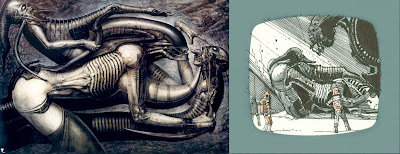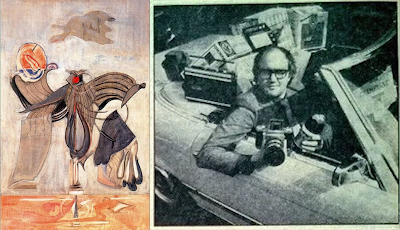leading from
a) The Space Jockey appears to have a body like a butterfly cocoon and a head like a seventeenth century plague doctor's mask.
He sits of a chair that resembles a human form on all fours with raised buttocks as the top of the back rest of the chair, perhaps there's an echo of Stanley Kubrick's Clockwork orange that featured tables in the form of naked women, but we know that Ridley took HR Giger's Necronom V as a starting point.
- HR Giger: From the script I knew he was huge and had a hole in his chest, but that was all. Ridley suggested another of my Necronom creatures as a guide. They don’t look much alike now, but it was a starting point; and the space jockey kind of grew up from there in bits and pieces. The creature we finally ended up building is biomechanical to the extent that he has physically grown into, or maybe even out of, his seat – he’s integrated totally into the function he performs. (Cinefex#1, p64, 1979.)
- HR Giger: From the script I knew he was huge and had a hole in his chest but that was all. (Alien The Archive, p52, taken from Cinefex#1)
- HR Giger: They don't look much alike but it was a starting point, and the Space jockey grew from there in bits and pieces (Alien The Archive, p52, taken from Cinefex#1 minus one word)
- HR Giger: Physically grown into, or maybe out of, his seat. He's integrated into the function he performs. (Alien The Archive, p52, taken from Cinefex#1)
- FX: What was the inspiration for the Space Jockey? H R Giger: Ridley Scott pointed to a part on the top of my painting Necronom V and asked me to do something like it. (FX, 7, 1999 (spanish magazine))
- Ridley Scott: As
they enter the derelict, I wanted them to come up over the edge of
something and into this vast chamber that's dominated by a huge chair.
In preparing this frame of the storyboard, I went through Giger's
Necronomicon and took this character, whom we call the "space jockey",
because I wanted a fossil, almost, one which you'd have a hard time
deciding where he leaves off and the chair, on which he died, begins. So
here they are with this dead space jockey frozen in death to the weapon
he was firing when he died. And he's kind of gargoyle-like and spooky. Sometimes we got very close to the films visuals in the storyboard"
(Fantastic Film, number 11 (US), p 28-29)
b) See: Evolution of the Space Jockey via Giger's Necronomicon
Giger's Necronom I believe references both Frantisek Kupka's L'Acier Travaille , Rothko's Gesthemane and the Pink Panther cover, along with numerous other compositions and items
but their relationship is covered below
b) Necronom V references the cover of The Pink Panther #33 comic book via photo of Gunilla Bergstrom at Eiffel Tower, Paris by Helmut Newton
b.i) See also: Photo of Gunilla Bergstrom at Eiffel Tower, references the cover of The Pink Panther #33 Paris (1976) by Helmut Newton
d) Evolution of the space jockey via Frantisek Kupka's L'acier Travaille, via the Pink Panther comic book#33 cover?
d.i) See: References the cover of The Pink Panther #33 (April 1976)?
d.ii) See: Space Jockey (1978) by Ridley Scott for Alien references Frantisek Kupka's L'Acier Travaille (1927)?
d.iii) See: The cover of The Pink Panther #33 (April 1976) references Frantisek Kupka's L'Acier Travaille (1927)?
e) Evolution of the space jockey via Rothko's Gesthemane, and publicity image with James Burke for The Burke Special in The Radio Times, (19th July 1973)?
e.i) See: References publicity image with James Burke for The Burke Special in The Radio Times, (19th July 1973)?
e.ii) See: References Mark Rothko's Gethsemane (1944)?
e.iii) See: Publicity image with James Burke for The Burke Special in The Radio Times, (19th July 1973) references Mark Rothko's Gesthemane (1944)?
f.) From The Painter's Eye to Inspector #4 to Interior, Nice to Bed Station to cover for "The Bicentennial Man" to the early Space Jockey storyboard
f.i) References “The Painter’s Eye” (1942) by Salvador Dali is referenced in Cover of Inspector #4 is?
f.iii) See: Cover of Inspector #4 is referenced in Interior, Nice (1976) by Helmut Newton?
e.vii) See: IInterior, Nice (1976) by Helmut Newton is references Interior, Nice (1976) by Helmut Newton?



%20%20Gunilla%20Bergstrom%20at%20Eiffel%20Tower,%20Paris%20(1976)%20by%20Helmut%20Newton%20was%20referenced%20in%20necronom%20v.png)
%20referenced%20in%20Gunilla%20Bergstrom%20at%20Eiffel%20Tower,%20Paris%20(1976)%20by%20Helmut%20Newton.jpg.png)

%20by%20Helmut%20Newton%20was%20referenced%20in%20necronom%20v.png)











%20(1976)%20by%20HR%20Giger%20references%20%E2%80%9CThe%20Painter%E2%80%99s%20Eye%E2%80%9D%20(1941)%20by%20Salvador%20Dali%20140722867_10225065020992115_7636746120057004907_n.jpg)
%20to%20Interior,%20Nice%20(1976)%20by%20Helmut%20Newton%20%20294470120_10228484852885775_989821647664026862_n.jpg)

%20by%20Chris%20Foss%20references%20the%20cover%20of%20The%20Inspector%20%234%20(April%201975)%3F%20294333707_10228485052970777_9039903814796313357_n.jpg)
%20by%20Ridley%20Scott%20references%20Interior,%20Nice%20(1976)%20by%20Helmut%20Newton%3F294390868_10228484986929126_4874608783966543642_n.jpg)
%20%20by%20Helmut%20Newton%20to%20Giger's%20Bedstation%20(1976)294298994_10228484831805248_3539179657879354046_n.jpg)
%20by%20Chris%20Foss%20references%20Bed%20station%20I%20(work%20329)%20(1976)%20by%20HR%20Giger%3F271187294_1022731314943.jpg)
%20by%20Ridley%20Scott%20references%20the%20cover%20for%20Isaac%20Asimov's%20The%20Bicentennial%20Man%22%20(Published%201978)%20by%20Chris%20Foss%3F%20294700631_10228501601784487_51917457247743982_n.jpg)

No comments:
Post a Comment